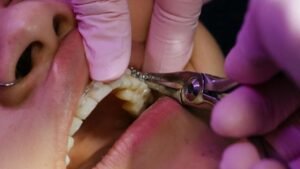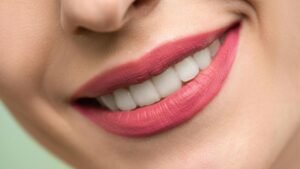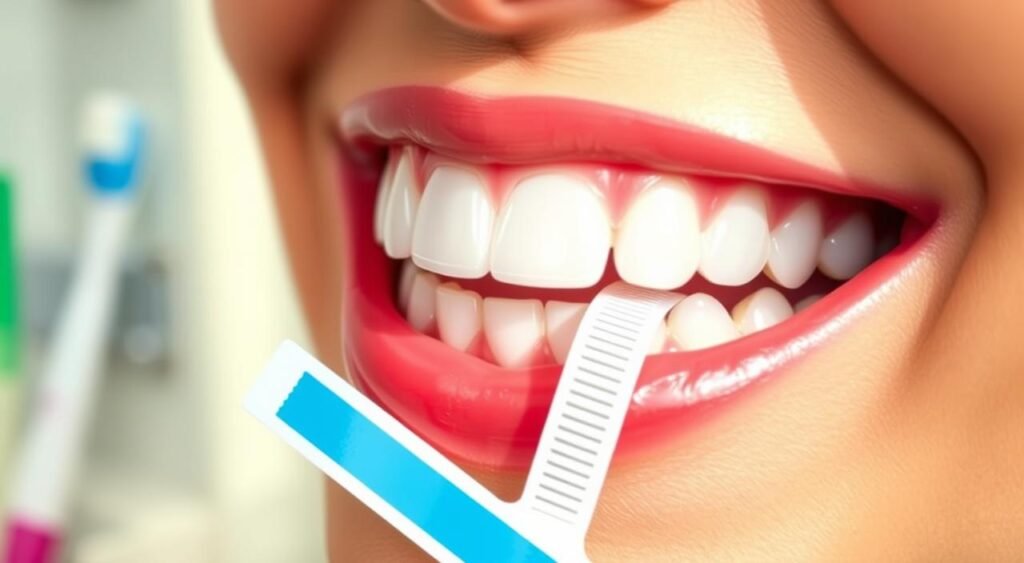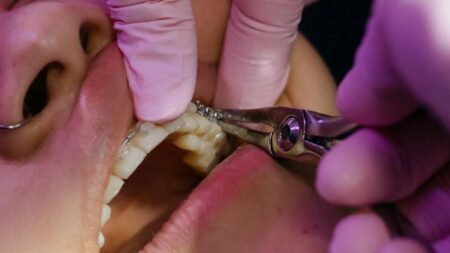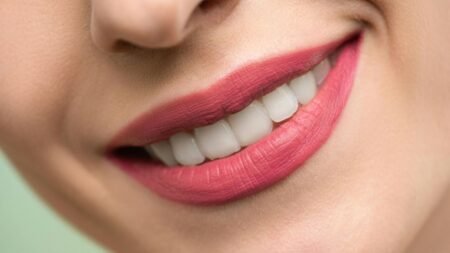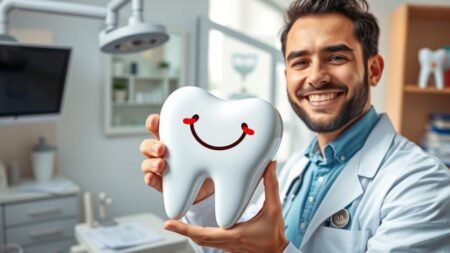Ever wondered if you should brush your teeth after using whitening strips? You’re not alone. Millions of Americans want brighter smiles, and strips are an easy way to get them at home. But, what’s the right way to care for your teeth when using these products?
Whitening strips have hydrogen peroxide or carbamide peroxide. You wear them for 30 minutes, once or twice a day, for two weeks. They can remove stains, but using them right is key to avoid problems like sensitive teeth and gum irritation.
Knowing when to brush after using strips is important. Some dentists say wait at least 30 minutes before brushing. This helps your enamel heal and lowers sensitivity risk.
Starting your whitening journey? Follow the strip instructions closely. From cleaning before to after, each step is vital for a bright smile. Let’s explore the best times to brush after whitening for safe and effective results.
How Teeth Whitening Strips Work
Teeth whitening strips are a favorite for brighter smiles. They use peroxide-based gels to remove stains, making your teeth whiter over time.
Active Ingredients in Whitening Strips
Hydrogen peroxide is the main ingredient in most strips. It breaks down stains in your enamel. These strips work best on yellow stains from coffee or tobacco.
The Science Behind Teeth Whitening
The peroxide in strips releases oxygen molecules. These molecules break down stain bonds, lightening your teeth. This method works on surface stains but not as well on deeper stains.
Duration and Application Process
Most kits suggest using strips daily for 14 days. Apply them once or twice a day for 30 minutes. Always follow the instructions to avoid side effects like sensitivity.
Remember, don’t overuse strips to avoid enamel damage. Wait 30 minutes after use before brushing. If you feel discomfort, talk to your dentist for advice.
Are You Supposed to Brush Teeth After Whitening Strips
Many people ask if they should brush their teeth after using whitening strips. The best way to brush after whitening is a topic of debate. Dental experts usually suggest being careful.
Whitening strips have strong chemicals like hydrogen peroxide. These agents help remove stains but can weaken tooth enamel. Brushing right after using strips might not be the best idea.
Dentists say to wait at least 30 minutes before brushing your teeth after using strips. This break lets your enamel harden again. You can rinse with water to get rid of any leftover gel during this time.
When you do brush, use gentle strokes. Choose a soft-bristled toothbrush and avoid hard pressure. These steps help protect your enamel while keeping your mouth clean.
| Product | Price | Features |
|---|---|---|
| Crest 3D Whitestrips Professional Effects | $45 (discounted from $90) | Long-lasting results, enamel-safe formula |
| Crest Whitening Emulsions with LED Light | $70 | Fast-acting, leave-on formula with light technology |
| Crest 3D Whitestrips Original + LED Light | $75 | Combines strips with LED light for enhanced whitening |
Good oral hygiene is key when using whitening products. Brush your teeth twice a day with fluoride toothpaste. Also, make sure to visit your dentist regularly to keep your smile shining.
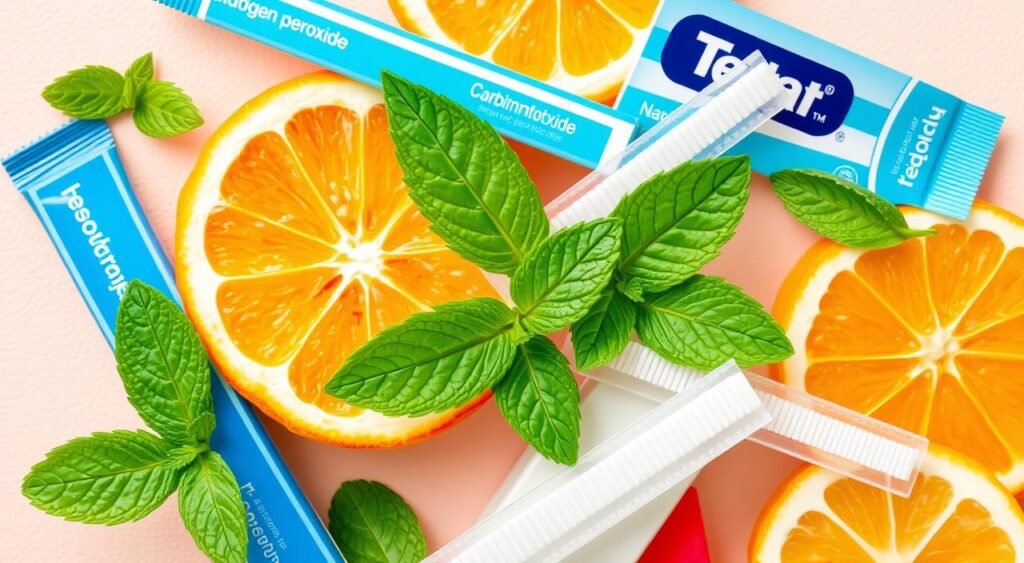
Potential Risks and Side Effects of Whitening Strips
Whitening strips can make your smile brighter. But, it’s important to know the possible side effects. Some people might feel discomfort or face complications.
Tooth Sensitivity Issues
Tooth sensitivity is a common issue with whitening strips. The peroxide can temporarily hurt your tooth nerves, causing pain. This pain usually goes away in a few days.
Gum Irritation Concerns
Your gums might get irritated if the strips touch them. This irritation is usually short-lived but can be uncomfortable. To avoid this, apply the strips carefully to not touch your gums.
Enamel Safety Considerations
Using whitening strips too much can harm your tooth enamel. The bleaching agents can wear away your enamel if used too often or wrong. Always follow the product’s instructions and don’t use it more than recommended.
| Side Effect | Cause | Duration | Prevention |
|---|---|---|---|
| Tooth Sensitivity | Peroxide penetration | Temporary | Reduce wear time, skip days |
| Gum Irritation | Strip contact with gums | Temporary | Careful application |
| Enamel Damage | Overuse of strips | Potentially long-term | Follow instructions, limit use |
Wait at least 30 minutes before brushing your teeth after whitening. This helps your enamel heal and lowers damage risk. Use a desensitizing toothpaste to help with sensitivity. Always follow the precautions to keep your mouth healthy.
Best Practices for Using Whitening Strips
Whitening strips are a simple way to brighten your smile. To get the best results, follow these steps and keep up with good oral care.
First, clean your teeth well. Then, apply the strips as directed, usually for 30 minutes each day. After taking them off, wait half an hour before brushing. This lets your enamel heal.
Use a soft-bristled toothbrush and gentle strokes to avoid hurting your gums. Pick a toothpaste that’s not too harsh to protect your enamel. Make sure to rinse your mouth well after each use.
Keep up with good oral hygiene while using whitening strips. Brush your teeth twice a day and floss often. This keeps your teeth looking good and supports your dental health.
| Product | Regular Price | Discounted Price |
|---|---|---|
| Crest 3D Whitestrips Professional Effects Value Pack | $90 | $45 |
| Crest Whitening Emulsions with LED Accelerator Light | $70 | $70 |
| Crest 3D Whitestrips Original + LED Light | $75 | $75 |
Be careful of tooth sensitivity, a common side effect. If you feel it, stop using the strips for a day or two. Using a sensitivity toothpaste might help.
Remember, whitening results come slowly. You might see changes in a week if you use them every day. For specific advice or if sensitivity is severe, talk to your dentist.
Proper Timing Between Brushing and Whitening
Timing is key when it comes to using whitening strips. Knowing when to brush after using them can greatly affect your results and oral health.
Waiting Period After Strip Removal
Wait at least 30 minutes before brushing your teeth after using whitening strips. This lets your enamel harden again. It also helps the whitening agents work better. Brushing too early can mess up the whitening and cause sensitivity.
Recommended Brushing Techniques
When you brush after using whitening strips, use soft, circular motions with a soft-bristled toothbrush. This gentle method cleans well without harming your enamel or gums. Don’t brush too hard, as it can hurt your teeth and gums during whitening.
Types of Toothpaste to Use
Use a non-abrasive toothpaste made for sensitive teeth. This kind of toothpaste protects your enamel and gums while whitening. Also, choose a fluoride toothpaste to keep your teeth healthy and prevent decay.
| Action | Timing | Recommendation |
|---|---|---|
| Brush before whitening | At least 30 minutes prior | Enhances strip adherence |
| Apply whitening strips | As per product instructions | Follow duration carefully |
| Brush after whitening | Wait 30 minutes minimum | Use gentle technique |
Don’t forget to see your dentist regularly while whitening your teeth. They can give you specific advice on when to brush after using whitening strips. They’ll help you keep your smile healthy and bright.

Maintaining Results After Whitening Treatment
After using whitening strips, you’ll want to keep your smile bright. Proper oral care with whitening strips doesn’t end when you remove them. Let’s explore how to maintain white teeth after strips and ensure your dazzling results last.
Dietary Considerations
What you eat and drink plays a big role in maintaining white teeth after strips. Avoid staining foods and drinks like coffee, tea, red wine, and dark berries. If you do indulge, rinse your mouth with water afterward. Smokers should consider quitting, as tobacco can quickly undo whitening effects.
Oral Hygiene Routine
Proper oral care with whitening strips includes a solid hygiene routine. Brush twice daily with fluoride toothpaste and floss regularly. Wait at least 30 minutes after using strips before brushing to allow the whitening agents to work. This helps maintain your results and protects your enamel.
Follow-up Care
Regular dental check-ups are key for maintaining white teeth after strips. Your dentist can provide professional cleanings and advice on touch-up treatments. They’ll also monitor your enamel health, which is vital for lasting results.
Remember, overusing whitening strips can lead to sensitivity and enamel damage. Stick to the recommended usage guidelines and consult your dentist if you experience any issues. With these steps, you’ll enjoy a brighter smile for longer.
Conclusion
Teeth whitening with strips can make your smile brighter. But, taking care of your mouth is key. Do you brush your teeth after using whitening strips? It depends on a few things.
Dentists usually say wait at least 30 minutes before brushing after using strips. This lets your teeth rehydrate and recover. It’s important for your teeth’s health.
Good oral hygiene is vital for a healthy, shiny smile. Brushing twice a day and flossing often keeps your teeth white. The timing of brushing can affect your whitening treatment’s success. Always check the product’s instructions.
For the best results and safety, talk to your dentist before whitening your teeth. They can give you advice on using strips right. By following these tips and caring for your mouth, you can keep your smile bright and your teeth and gums healthy.
Whitening Strips FAQ
Are you supposed to brush your teeth after using whitening strips?
Many dentists say wait at least 30 minutes after using whitening strips before brushing. This helps your enamel harden again. It also lowers the chance of damage. Always check the instructions on your strips and talk to your dentist for advice.
How do whitening strips work?
Whitening strips have gels with hydrogen peroxide or carbamide peroxide. These gels get into your enamel. They break down stains, making your teeth whiter. They mainly work on stains from coffee, tobacco, and colored foods.
How long should I leave whitening strips on?
The time you leave them on varies. It’s usually between 30 minutes to an hour a day. Always follow the instructions on your strips for the best results.
What are the possible side effects of using whitening strips?
You might feel some tooth sensitivity or gum irritation. Using them too much or wrong can damage your enamel. Not everyone gets these side effects. If you’re uncomfortable, stop using them and see your dentist.
Can I use whitening strips if I have sensitive teeth?
If your teeth are sensitive, talk to your dentist first. They might suggest a gentler product. If you do use them, pick a product for sensitive teeth and follow the directions carefully.
How can I maintain the results after using whitening strips?
To keep your teeth white, avoid foods and drinks that stain. Brush twice a day with fluoride toothpaste and floss often. See your dentist for cleanings and advice. Use touch-up treatments as directed to keep your teeth white.
Is it safe to use whitening strips regularly?
Whitening strips are safe for occasional use. But using them too much can harm your enamel. Always follow the instructions and talk to your dentist before starting a regular whitening routine.
Can I eat or drink immediately after using whitening strips?
Wait at least 30 minutes before eating or drinking after using strips. This lets your enamel harden again. Avoid staining foods and drinks for a few hours after treatment.
